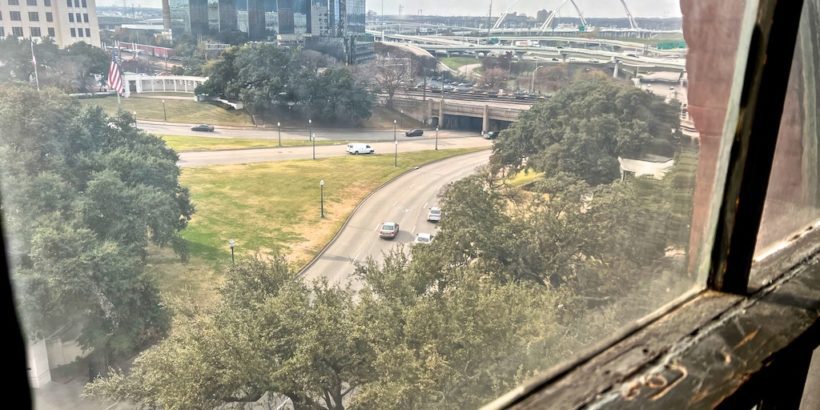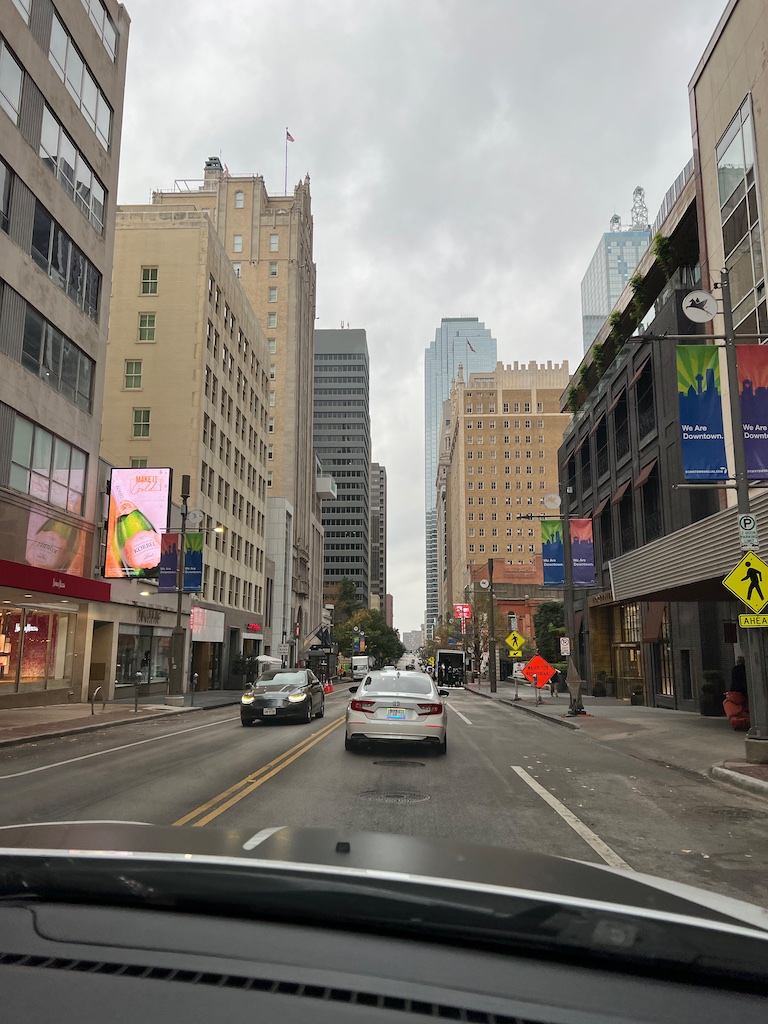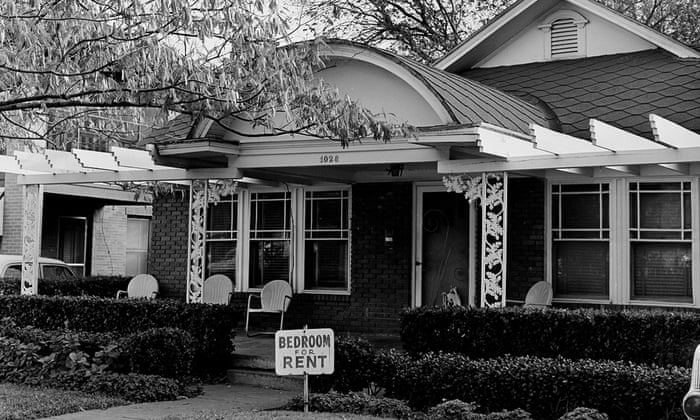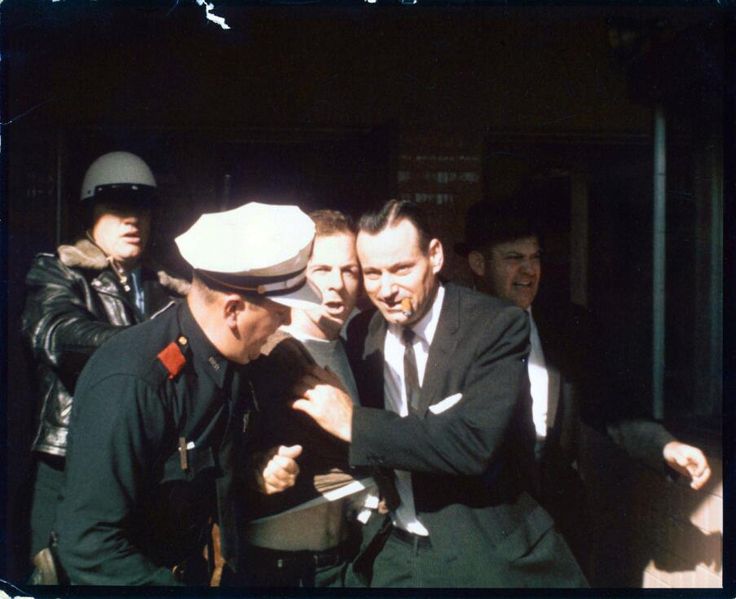If you’re interested in learning about the JFK assassination that occurred in Dallas and seeing all of the different sites associated to that tragic moment in history, you’ll find that the Dallas/Fort Worth area has 16 or so must-see sites you’ll want to visit.
In this article, I’ll give you all of the sites that you’ll want to check out and all of the historical and practical information you need to know about them in order to have a smooth and meaningful visit.
Table of Contents
How to see JFK Sites in Dallas (overview)
I recommend roughly following the order below because it’s ordered in a way that factors in both the sequence of events and driving efficiency.
This itinerary begins in Fort Worth where JFK began his time in DFW and delivered his two final speeches and then takes you to Dallas and follows along the motorcade route.
Once you finish that, you can experience all of the downtown Dallas destinations, including places like the Sixth Floor Museum and Grassy Knoll before moving on to grab a bite at a historic lunch spot tied to the shooting.
After you’ve had your Italian food fix, you’ll head down to the Oak Cliff area of Dallas and hit up a few more spots that will shed light on Lee Oswald and even provide fodder for conspiracy theories.
To wrap up, you can make your way to Irving, Texas, and finish up at the Ruth Paine House where you can learn more about what Oswald’s life was like in the weeks leading up to the assassination.
Checking out all of these locations will give you a comprehensive set of experiences and really help you understand the full spectrum of events that may or may not have taken place on November 22, 1963.
After doing the itinerary below, I walked away with a better understanding of the JFK assassination, lots of new questions, and also another level of admiration for the former president.
If you want to see all of the sites below, give yourself a full day or if you want to move at a more leisurely pace, a day and a half.
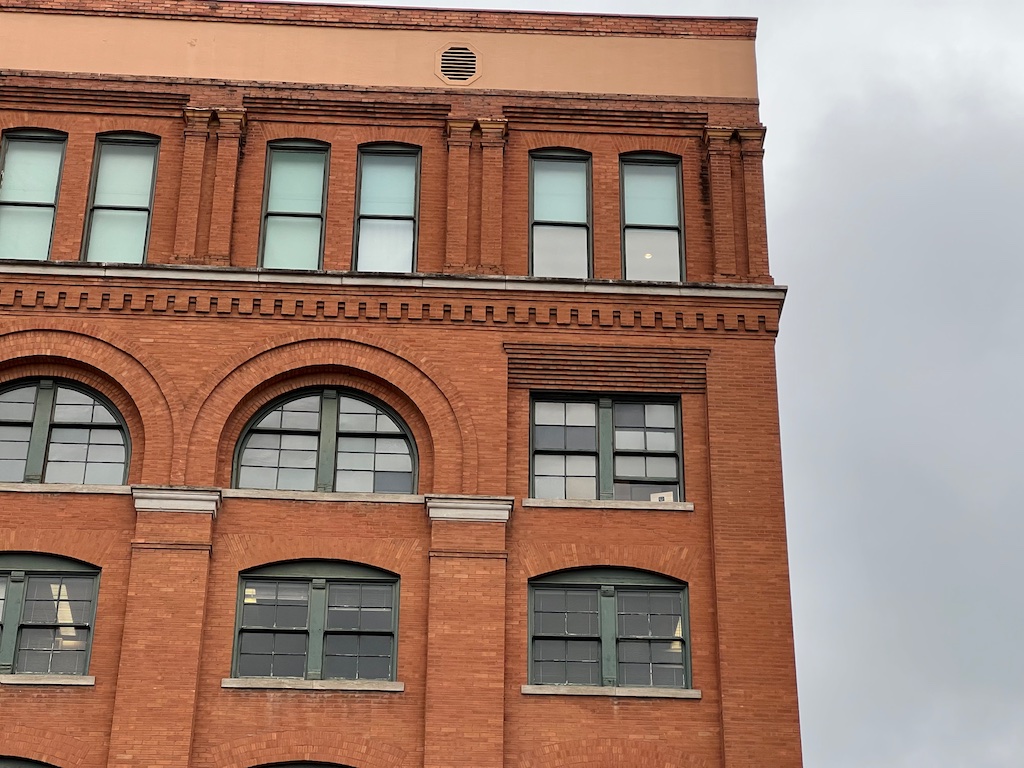
Background to JFK’s 1963 visit to Texas
Before visiting all of the sites in Dallas, it helps to have a bit of context as to what JFK was doing in Texas.
In June of 1963, while visiting in El Paso, Texas, and meeting in the Hotel Cortez, Kennedy agreed to a second presidential visit to Texas later on in the year.
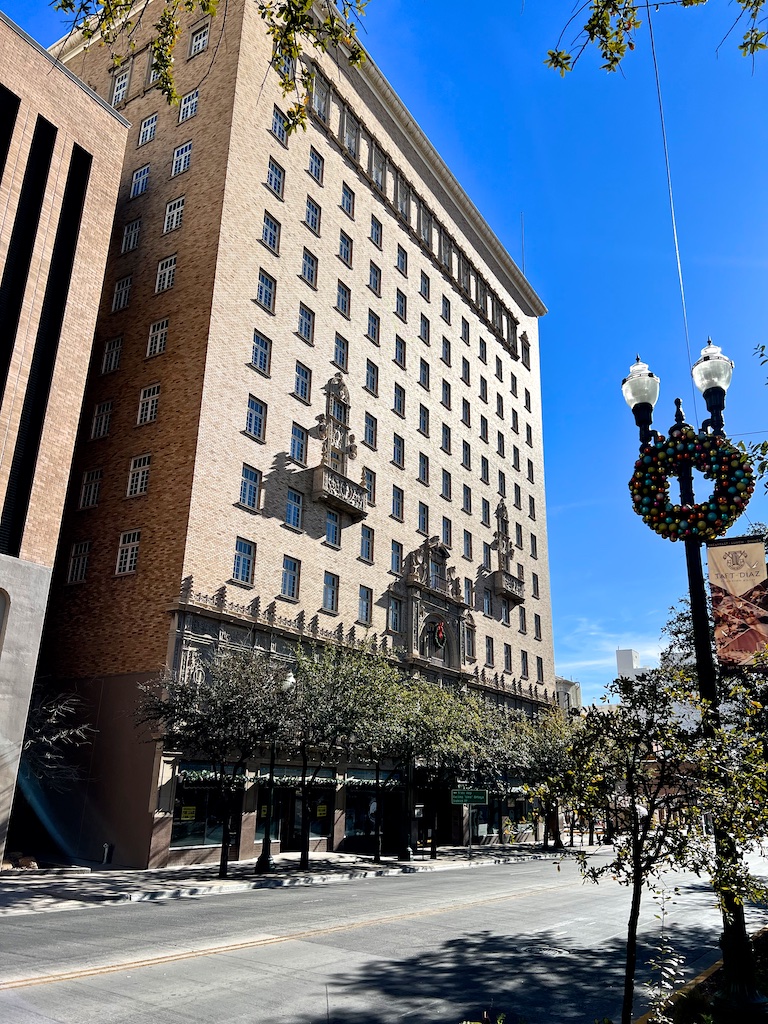
The goal of this visit was to to raise campaign fund contributions, boost his odds for re-election in November 1964, and end in-fighting among Texas Democratic Party members.
JFK planned a two day business visit with some leisure time after that.
On the first day, he would arrive in San Antonio and then later that day fly to Houston where he’d give an address at the Rice Hotel and testimonial dinner at the Sam Houston Coliseum.
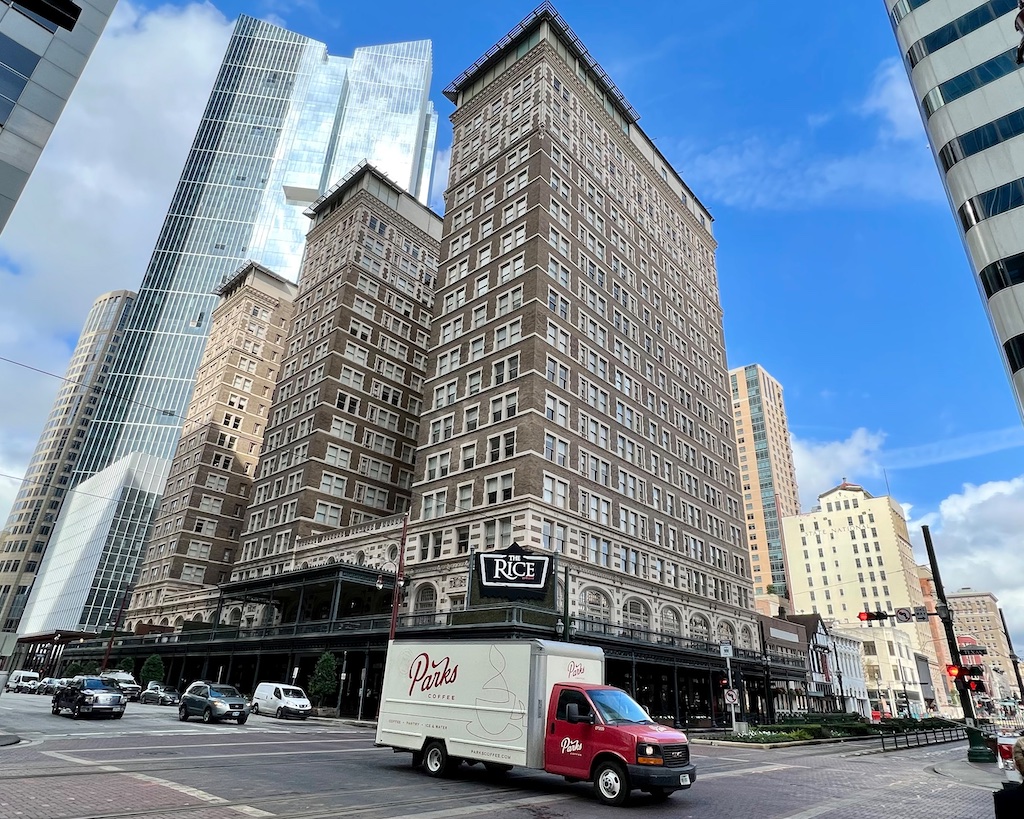
After dinner in Houston, he would make his way to Fort Worth aboard Air Force One and the next morning after attending a breakfast event he would head to the Dallas Trade Mart to give yet another speech.
Later that day he’d fly to Austin for a $100 per plate dinner at the Austin Municipal Auditorium with the hopes of raising some serious cash.
After all of the speeches were made, JFK and the entourage would enjoy some relaxation at LBJ’s ranch in the Texas Hill Country, where Lyndon Johnson would put on one of his epic barbecue events on the Pedernales River.
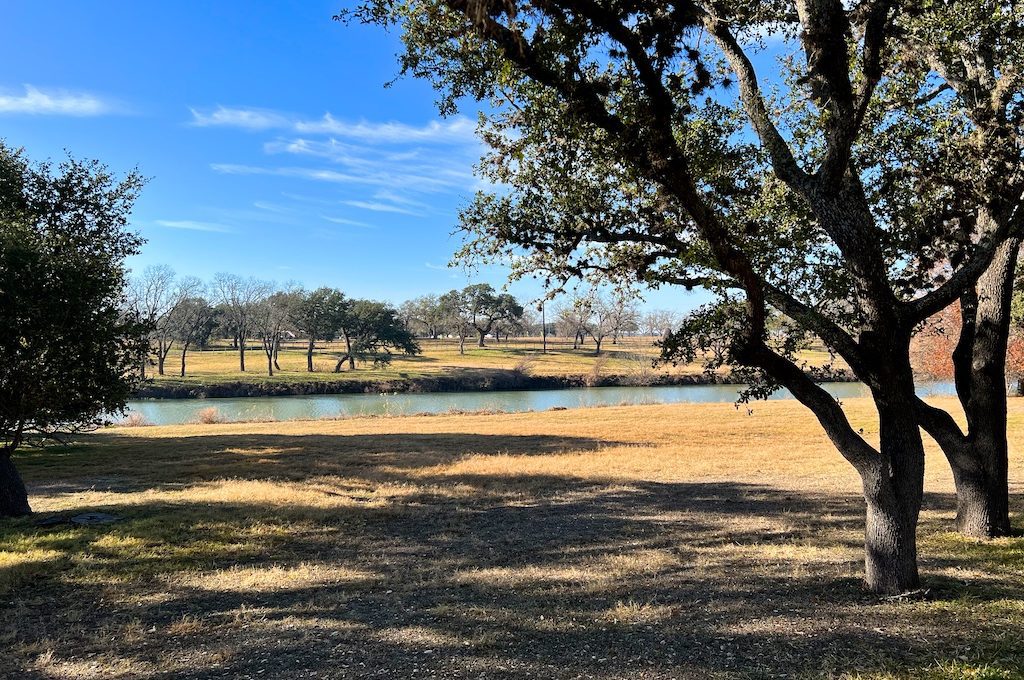
Because the election in Texas (and nation wide) was so close in 1960, the visit to Texas was a very crucial one.
Kennedy insisted on the protective bubble being removed from the Lincoln Continental convertible so that onlookers could get a close look at him and Jackie Kennedy.
He wanted to be exposed to the greatest number of people possible and make a strong connection with those potential voters.
One has to think that the decision to remove the protective bubble was largely motivated by him knowing he needed to do everything he could to increase his chances of winning Texas in the 1964 election, especially since he lost Dallas in 1960.
List of JFK sites
Now that you have little overview of how to visit the sites and some context for the visit, let’s jump into all of the JFK sites you’ll want to see.
First, I’ll give you a list of all the sites and then I’ll go into detail for each individual location.
- Hilton Fort Worth
- JFK Tribute
- JFK motorcade route
- JFK Memorial
- The white “X” (Dealey Plaza)
- Grassy knoll (Dealey Plaza)
- Sixth Floor Museum
- Campisi’s
- Dallas Municipal Building
- Lee Oswald’s old house
- Lee Harvey Oswald Rooming House Museum
- Officer Tippit memorial
- Texas Theater
- Ruth Paine House Museum
- The Trade Mart
- Parkland Hospital
Hilton Fort Worth
- Address: 815 Main St, Fort Worth, TX 76102
In Forth Worth, JFK spent the night at the Texas Hotel (currently the Hilton Fort Worth).
Some prominent members of the community wanted the President to be sufficiently impressed with his hotel room so they came together to furnish JFK’s hotel suite with original artwork from famous artists such as Picasso and Vincent van Gogh.
The original suite JFK stayed at on the eighth floor (room 850) has since been remodeled so the original room does not exist.
However, if you head to the eighth floor and go to the rooms near 808 and 810 that is reportedly where the old suite JFK stayed in was located.
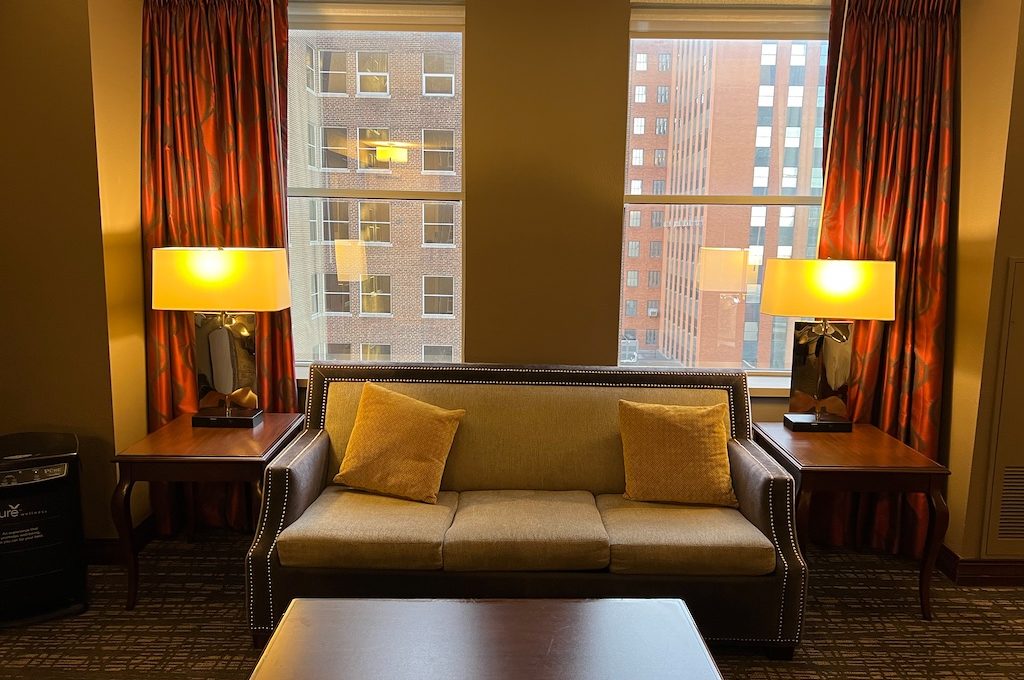
The morning of the shooting, JFK would give a speech to thousands of people outside the Texas Hotel and then head back inside to the Crystal Ballroom to give his final speech to the Fort Worth Chamber of Commerce over breakfast.
The ballroom shimmers a little different today and just outside it you can find dozens of framed JFK photos and news clippings from his visit to Fort Worth.
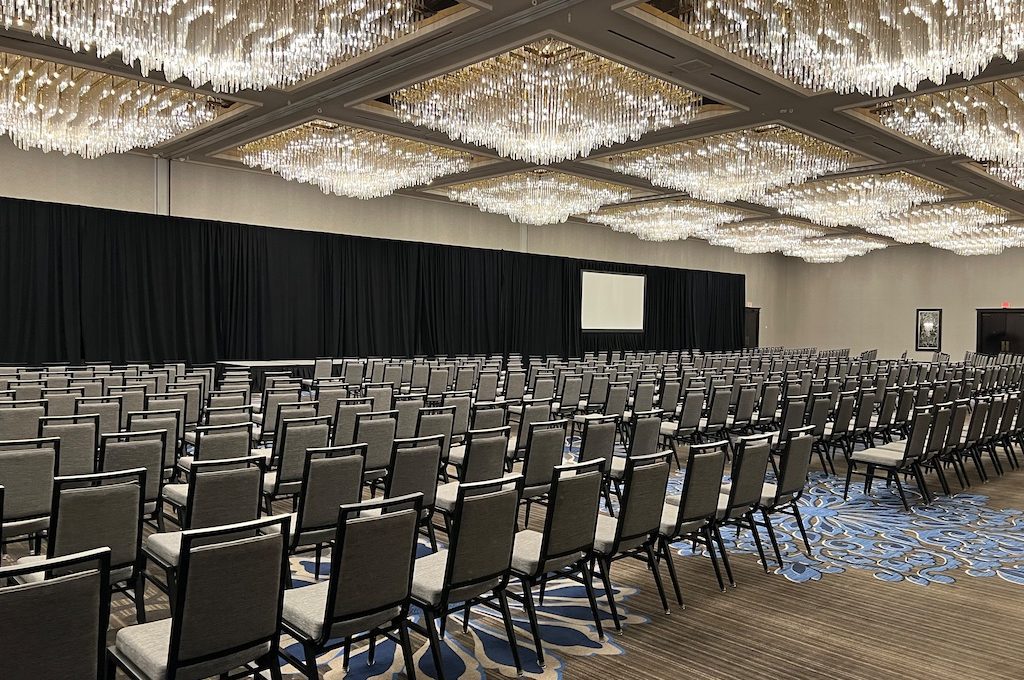
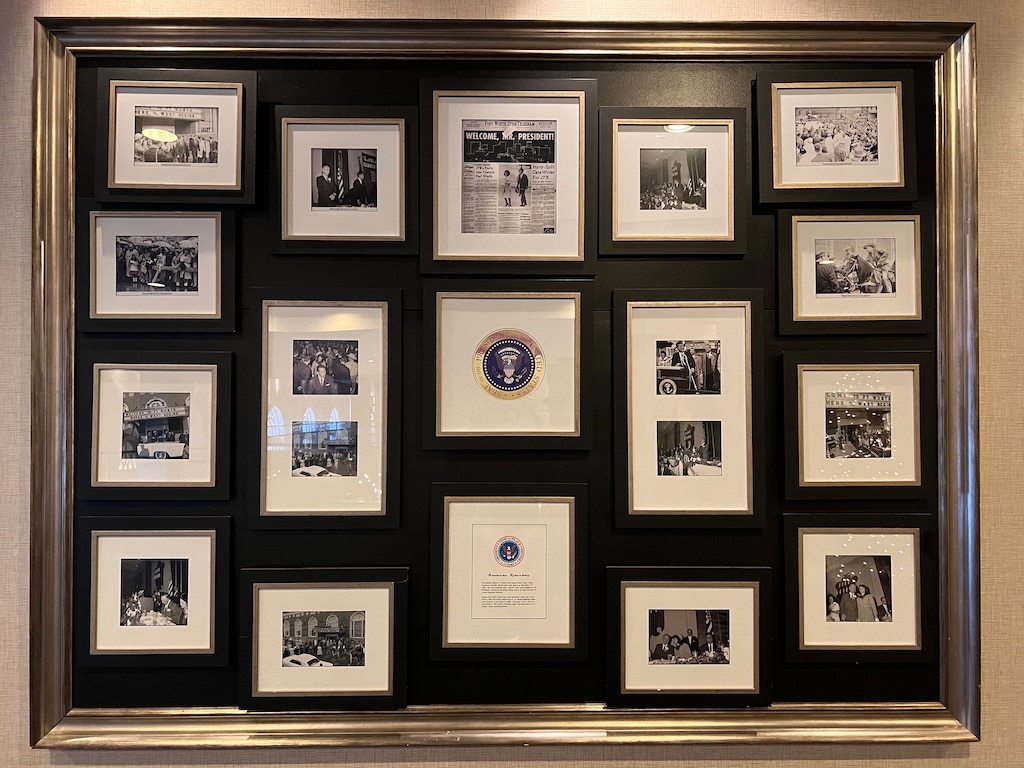
We decided to stay a night at the Hilton Fort Worth to fully immerse ourselves in the history. I really enjoyed the hotel and loved that it had such a historic feel to it on every floor. Rooms are not very expensive, either.
However, if you are able to splurge you can look into the special JFK suite up on the 15th floor but that might cost you $2,000+!
JFK Tribute
- Address: 916 Main St, Fort Worth, TX 76102
Just outside the Hilton Fort Worth, there is a tribute/memorial that is worth checking out that is located right where JFK gave his impromptu speech before breakfast.
Dedicated May 29, 2012, the tribute consists of a Lawrence Ludtke 8-foot-tall bronze statue, and a 10-foot, bowed granite wall engraved with memorable quotes and adorned with large photos from JFK’s visit to Fort Worth.
You can read about JFK’s legacy as you ponder what the scene would’ve been like outside the hotel close to 60 years ago as the 35th President of the United States gave one of his very last speeches.
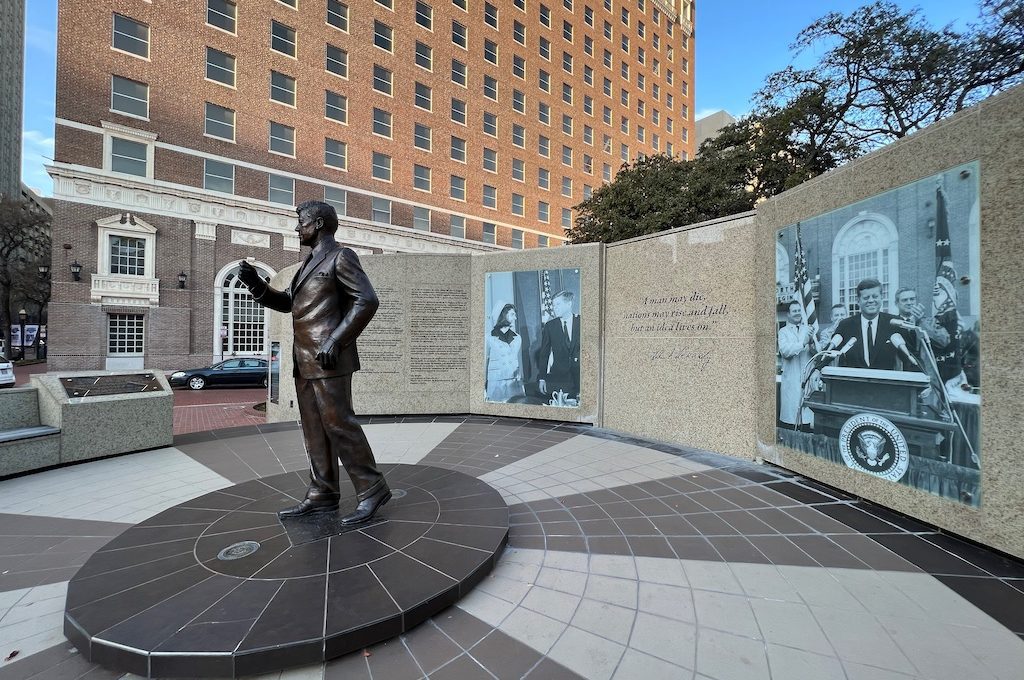
It’s kind of unbelievable but it’s reported that before JFK left the Hilton Fort Worth he made the following remark regarding presidential appearances:
“if anybody really wanted to shoot the President of the United States, it was not a very difficult job–all one had to do was get a high building someday with a telescopic rifle, and there was nothing anybody could do to defend against such an attempt.”
JFK motorcade route
- Address: Dallas
You can book tours that will take you along the JFK motorcade route or you can simply drive the route yourself like we did.
Use this map to follow the original motorcade route that JFK took leading up to his final moments before the assassination.
The route starts at Dallas Love Airport and then works its way through the heart of Dallas.
The streets along the route are almost exactly the same from 1963 but there will be a couple of occasions where you need to simply turn off the route and then get back on after a block or two.
These include Cedar Springs and Olive Street and Harwood Street and Woodwall Rodgers Freeway.
With morning traffic, it took us about 25 minutes to drive the full route and while it’s a little unremarkable in the beginning, if you’re like me, you’ll probably get goosebumps as you make the final slow turn on Elm Street.
It’s said that once the motorcade was nearing the spot of the shooting, Governer Connally’s wife, Nellie, turned to JFK and commenting on the lively crowds showing up, said, “Mr. President, you can’t say Dallas doesn’t love you!”
JFK then uttered his last words, “No, you sure can’t.”
John F. Kennedy Memorial Plaza
- Address: 646 Main, Dallas, TX 75202
After we finished the motorcade route we decided to park at the Sixth Floor Museum and then wander around to check out the nearby JFK sites.
The JFK Memorial was designed by famed architect Philip Johnson who called it “a place of quiet refuge, an enclosed place of thought and contemplation separated from the city around, but near the sky and earth.”
The monument, standing 30 feet tall and 50 by 50 feet, is an empty tomb, that “symbolizes the freedom of Kennedy’s spirit.”
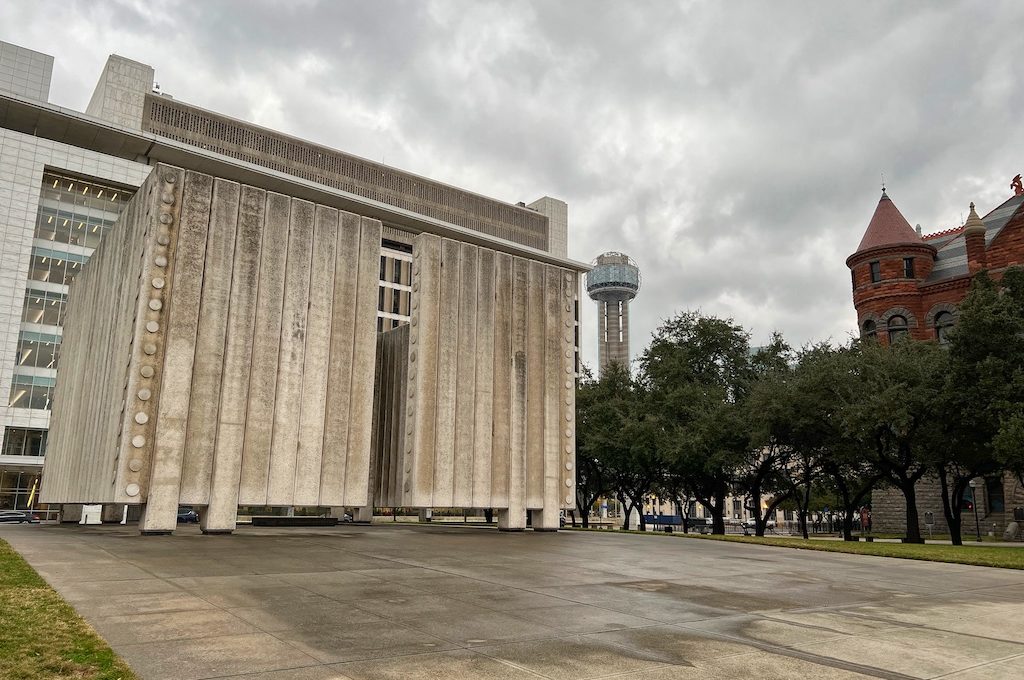
It’s an interesting memorial but it’s in serious need of some pressure washing.
I mean honestly, how dirty are these folks gonna let this memorial get?
Stained or not, some people aren’t impressed by it and while sections do sort of look like a giant lego piece it’s still worth checking out mostly because it’s free and only takes a couple of minutes to visit.
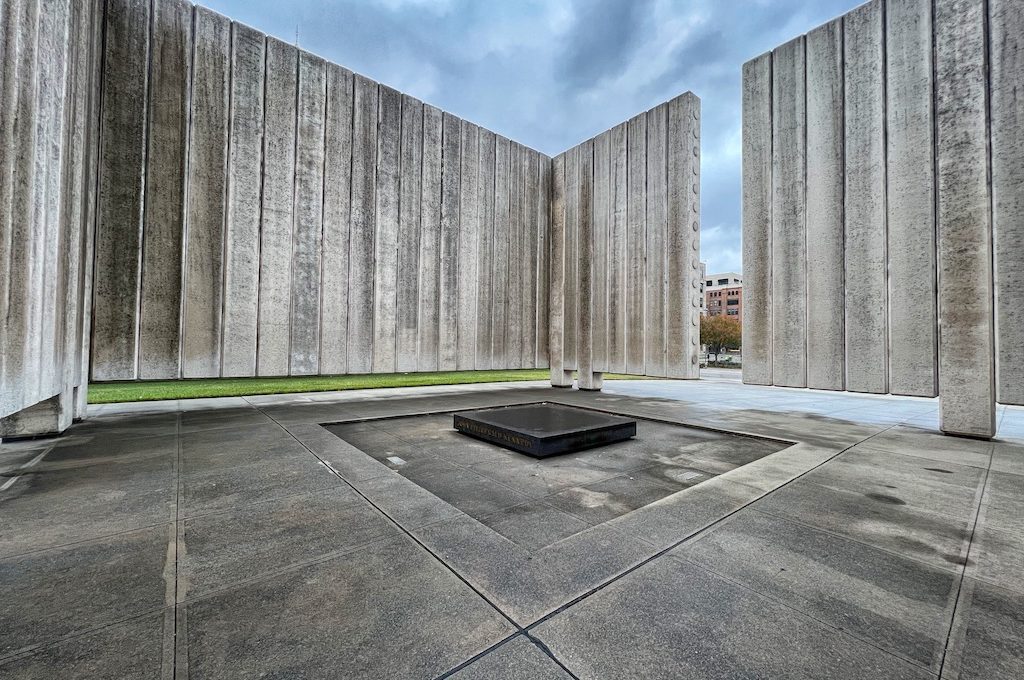
The white “X” (Dealey Plaza)
Elm Street has white “X”s painted on the pavement where JFK was shot, including where the fatal headshot occurred.
Interestingly, the city of Dallas does not place these white Xs on the street and nobody knows exactly who does it. The Xs are periodically removed when the streets are re-paved but they always reappear virtually immediately.
The city does not object to them and just lets them be but some people do dispute that they are placed accurately.
Whether or not “X” actually marks the spot, heading down to Elm Street and checking out the white Xs is moving, especially when you gaze back up at the half-opened window on the sixth floor of the old Texas School Book Depository.
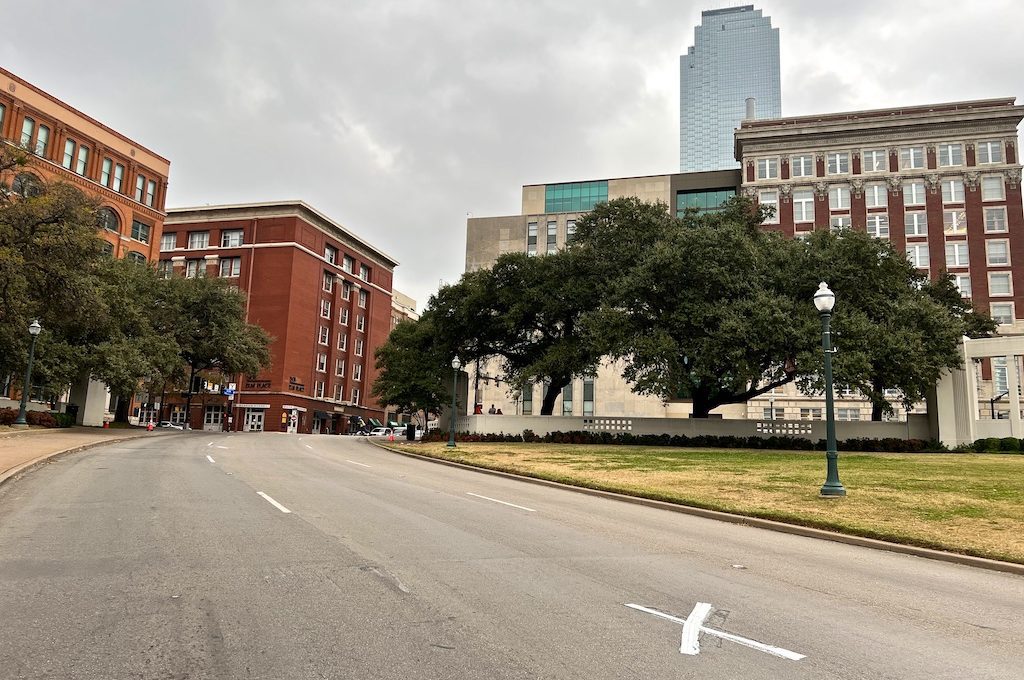
Grassy knoll (Dealey Plaza)
The infamous grassy knoll at Dealey Plaza is where many conspiracy theorists assert a second shooter was located.
Reportedly, some people saw a plume of smoke in the trees near the grassy knoll which would have indicated a second shooter.
Others reported strange activity in the area like unfamiliar automobiles in the rail yards and two men standing behind the fence, suggesting that something was not quite right.
The grassy knoll and Dealey Plaza make up a pretty small area but you can find a hand full of interpretive panels located throughout the plaza that give you some insight into the history.
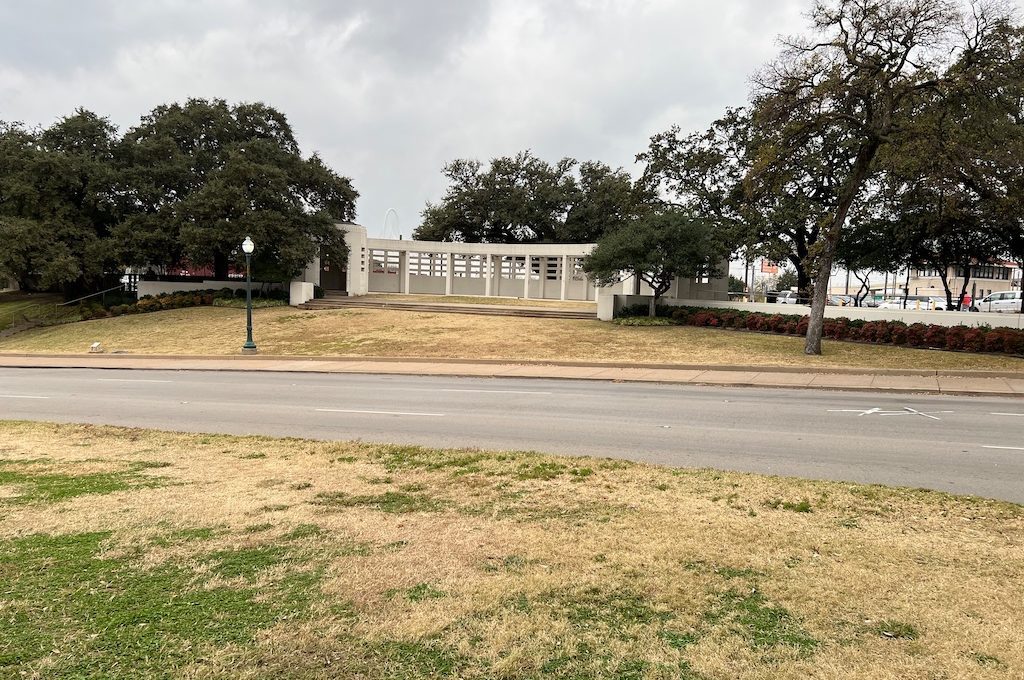
You can also stand right where the Zapruder film was shot and view the scene from the exact same angle which I thought was pretty interesting.
We visited this area around 9am so crowds were minimal to nonexistent but it does seem like this area gets quite busy at peak times.
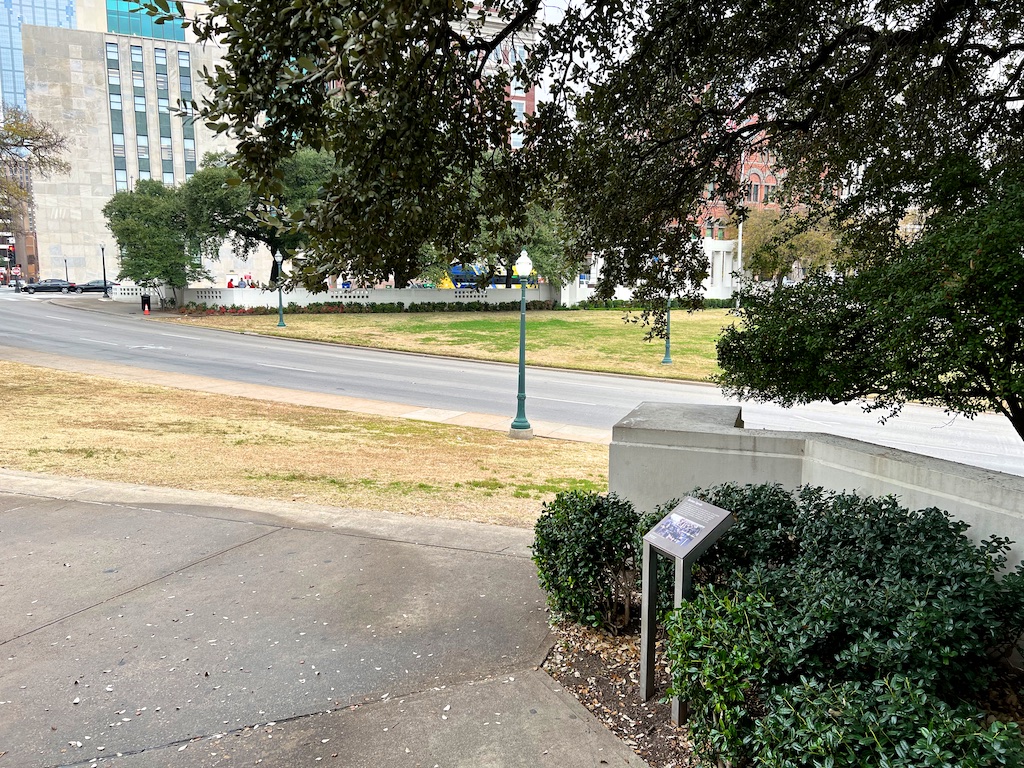
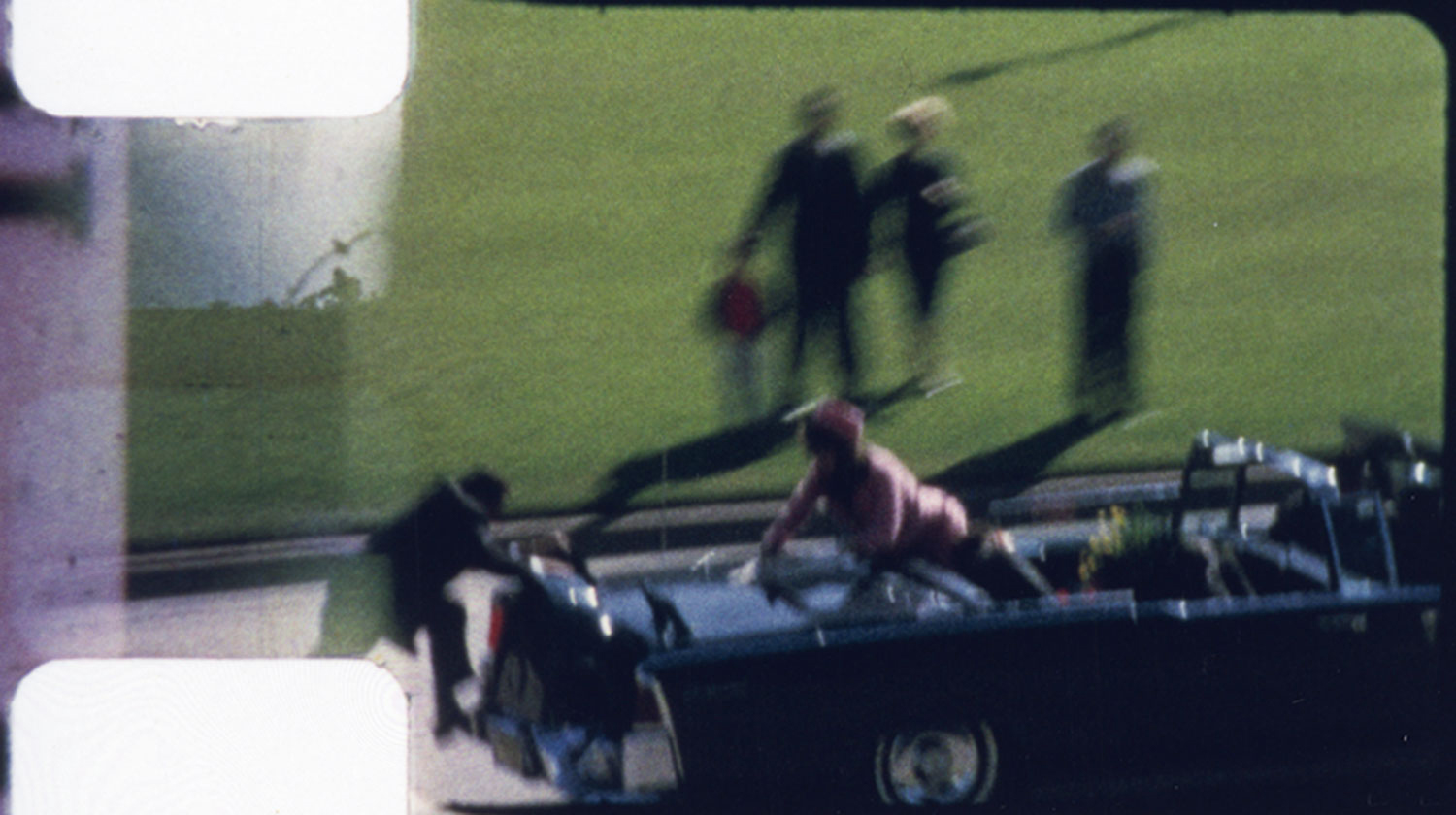
Sixth Floor Museum
- Address: 411 Elm St, Dallas, TX 75202
The Sixth Floor Museum is an absolute must for anyone interested in the JFK assassination.
The main attraction at this museum is probably the “sniper’s perch” which is the corner of the Texas School Book Depository building where Oswald allegedly fired three shots at John F Kennedy.
This is where they found the rifle which was traced to Oswald along with three shells.
The corner is assembled with cardboard boxes to look just like it did the day Oswald was up on sixth floor. It’s pretty ominous when you first see it.
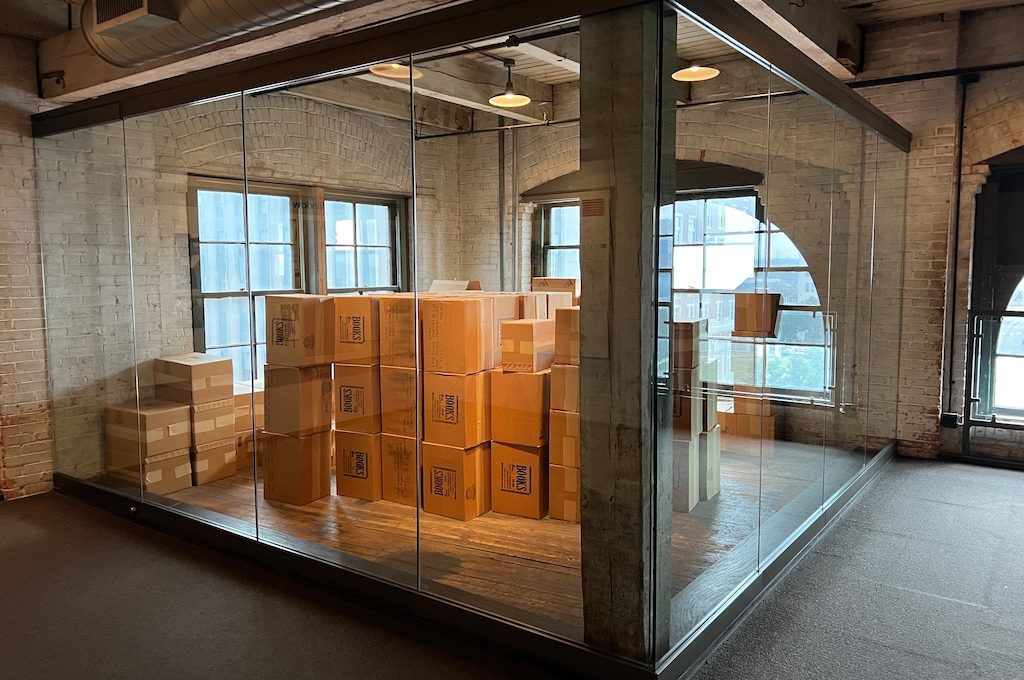
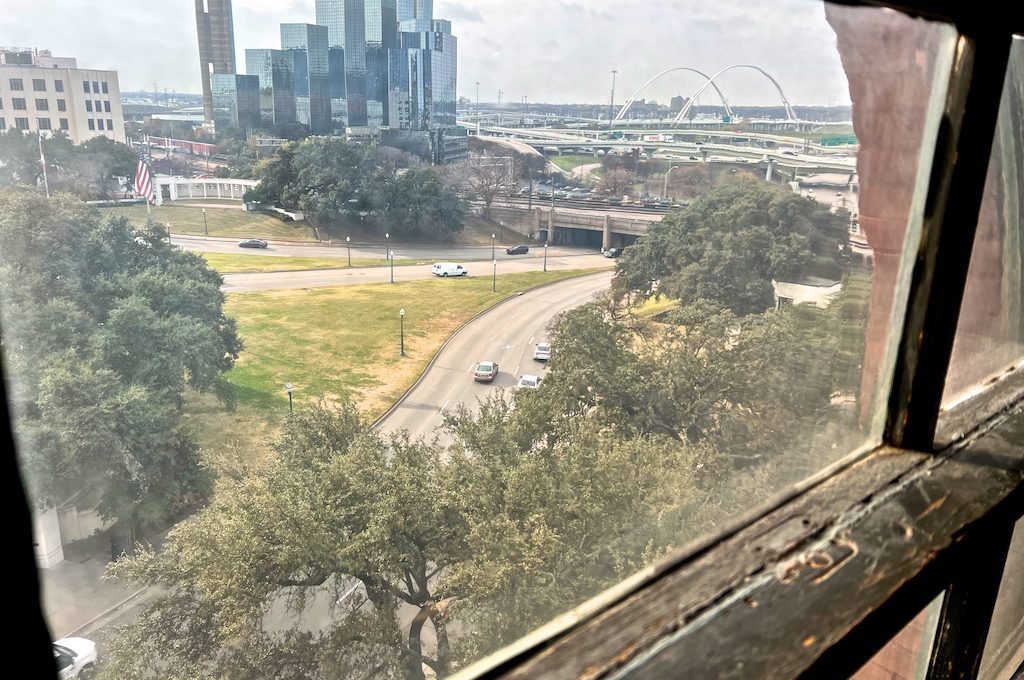
While the entire corner is glassed-off, you can head up to the seventh floor and take a look at the corner view which would be almost the exact same view the shooter had.
The Sixth Floor Museum goes well beyond the assassination and gives you insight into the life and career of JFK with many interpretive exhibits.
In addition to the exhibits, there are some interesting artifacts like the wedding ring of Lee Oswald, a replica of the rifle used, and models of cameras used to capture JFK’s final moments.
I recommend that you buy your timed-entry tickets in advance so that when you arrive at the time of opening you can get in and hopefully avoid the crowds.
Tickets are $18 per adult but note the museum is closed on Monday and Tuesday. Give yourself about an hour and a half for the self-guided experience.
We arrived at the parking lot around 9am and parking was plentiful. For the day parking cost $12.
You can read my full review of the museum here.
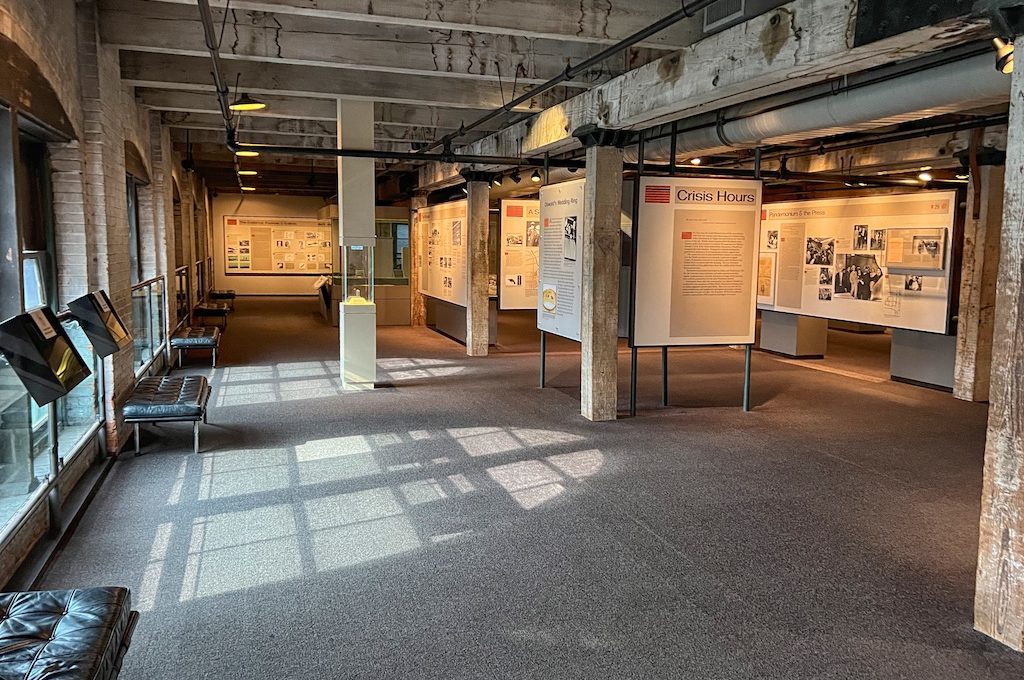
Campisi’s
- Address: 5610 E Mockingbird Ln, Dallas, TX 75206
Once you have worked up a little bit of an appetite, head over to the original Campisi’s restaurant for lunch.
This is a restaurant that Jack Ruby frequented a lot and that he visited the night before the JFK assassination.
Jack Ruby was the individual who killed Lee Oswald only a couple of days after Oswald was apprehended.
The owner of the restaurant, Joe Campisi allegedly had mob ties and to add even more mystery, he and his wife visited Jack Ruby in jail after Ruby killed Oswald and nobody knows what they discussed.
For those who believe in a mob connection to the assassination, this raises a lot of questions, including the possibility that the mob killed Lee Oswald to keep him quiet.
While there’s a lot of uncertainty around Joe Campisi and Jack Ruby, the good news is that there’s certainty that the food is good and you can’t go wrong with their thin crust pizza.
Tip: If you have more than two people, ask for the Jack Ruby booth (the actual booth he ate at).
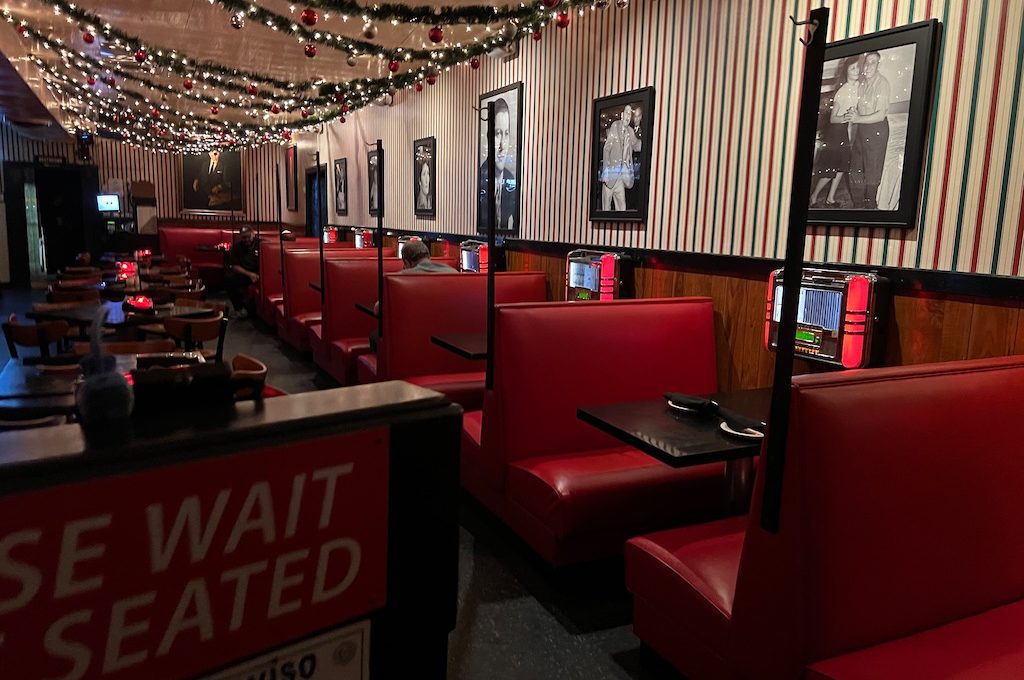
Dallas Municipal Building
- Address: 106 S Harwood St, Dallas, TX 75201
Opened in 1914, the Beaux-Arts Style Dallas Municipal Building is the old police station where Lee Oswald was taken after he was arrested and it’s the same spot where he was eventually shot and killed by Jack Ruby.
While being transported to an armored car that would take Oswald from Dallas City Jail to Dallas County Jail, Jack Ruby stepped away from a group of reporters and shot Oswald point-blank range in the abdomen with a .38 Colt Cobra revolver.
Right after he was shot, Oswald was asked, “Do you have anything you want to tell us now?”
He shook his head “no” just before going unconscious. And that was it.
The shooting was broadcast on live TV and so Oswald was the first known person to ever be murdered on live television.
How did the onlookers react?
It’s reported that once the crowd outside the police headquarters found out who had been shot, they erupted into an applause.
On March 14, 1964, Ruby was convicted of murder with malice and was sentenced to death but his conviction was overturned. While he was waiting for a new trial, he died of a pulmonary embolism on January 3, 1967.
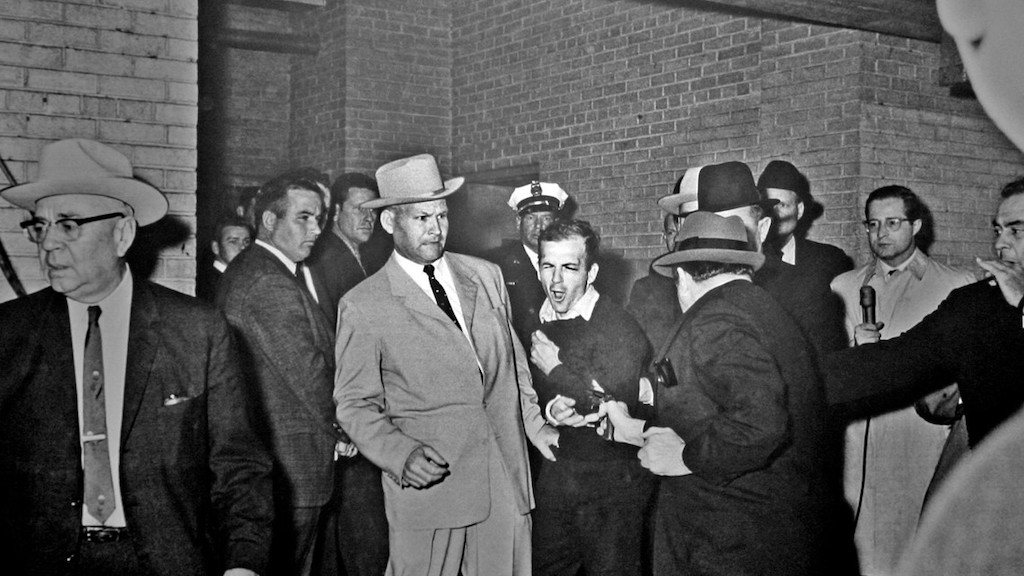
Today, the Dallas Municipal Building is the home of University of North Texas Law School.
Oswald’s jail cell on level 5 has been preserved along with other areas from that time, but I don’t think any of the sites are open to the public for regular viewing.
Reportedly, the Oswald’s jail cell was also the cell used for Jack Ruby after he killed Oswald.
Oswald was shot in the basement where the parking garage connected to the building so it’s not visible from the outside. However, it’s still interesting to check out the building and if you contact the right people you might be able to access the interior.
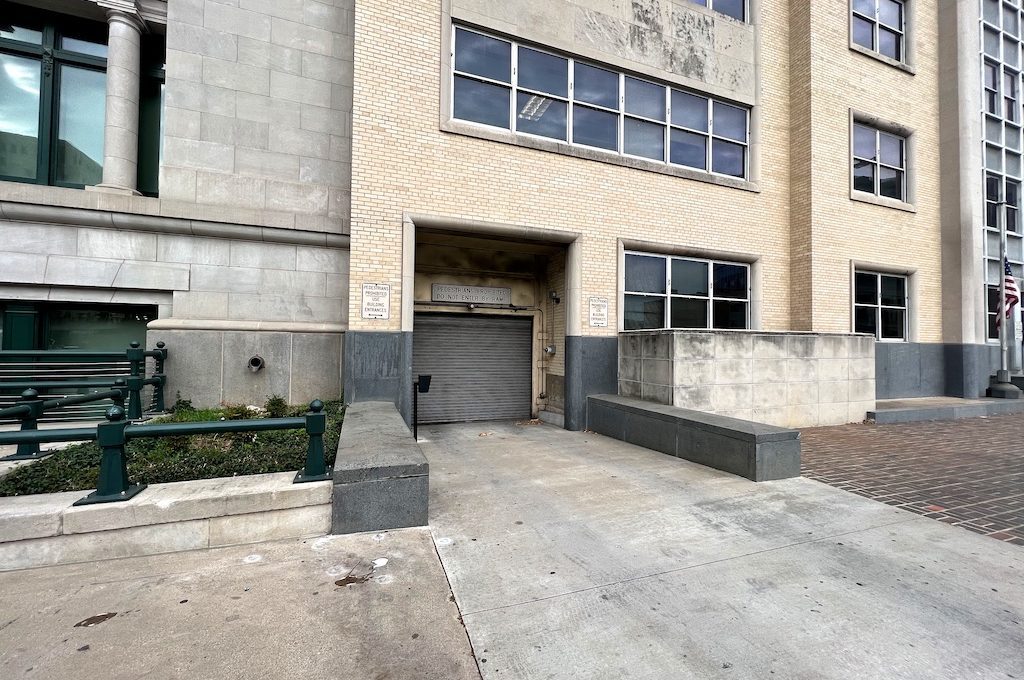
Lee Oswald’s old house
- Address: 214 W Neely St, Dallas, TX 75208
When the Oswalds returned from Russia, they lived in this house from March 2, 1963 to April 24, 1963.
This is the house where Oswald was spotted in the infamous photo of him holding his rifle and two newspapers later identified as the Worker and the Militant.
It’s believed that the rifle in the photo is the same rifle that was used to shoot JFK.
Some people have claimed that that photograph was doctored but analysis of the photos have shown otherwise.
Today, the building looks like an old, creepy abandoned house but you can still view the stairs in the backyard.
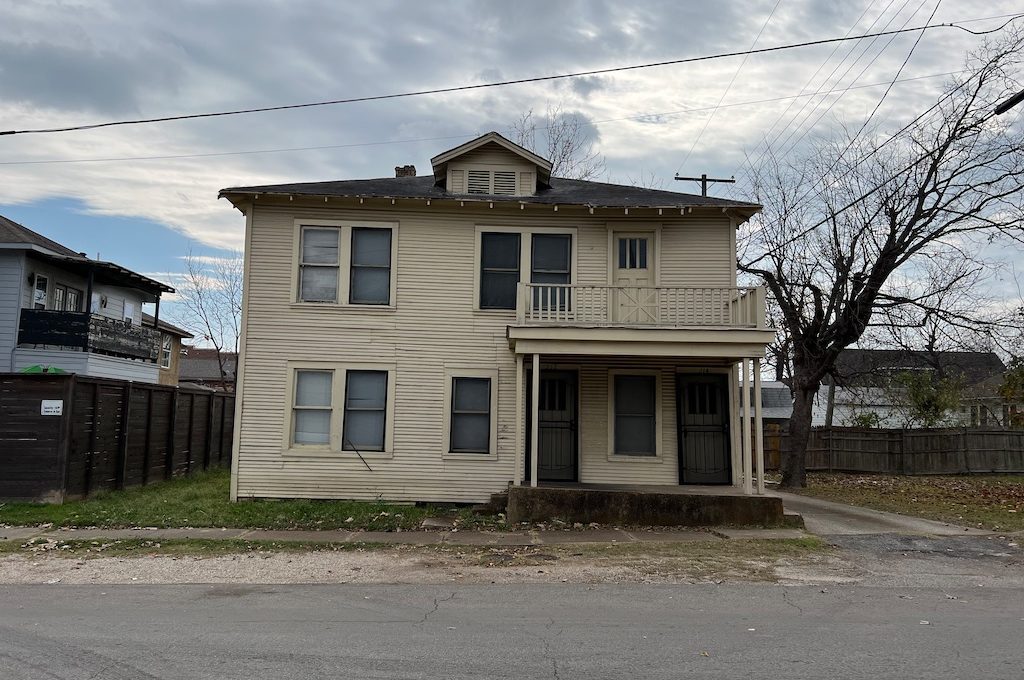
There are openings in the fence which would allow someone to get into the backyard and take a picture under the stairs.
I’m not big on trespassing in Texas and would have felt a little weird re-enacting that photo so we just got our shots from the outside of the fence.
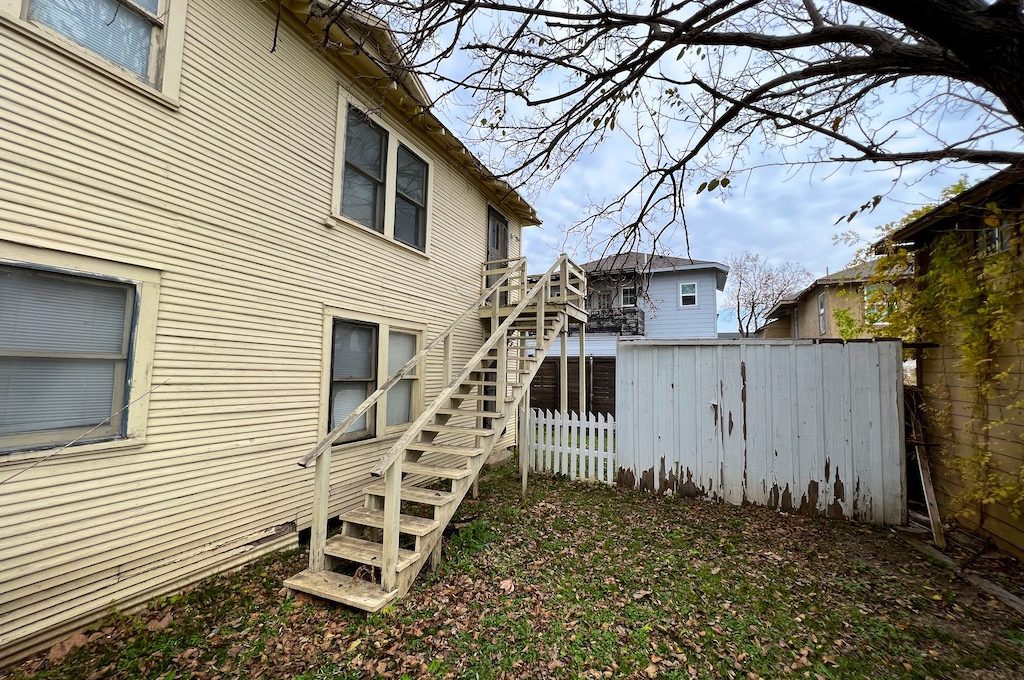
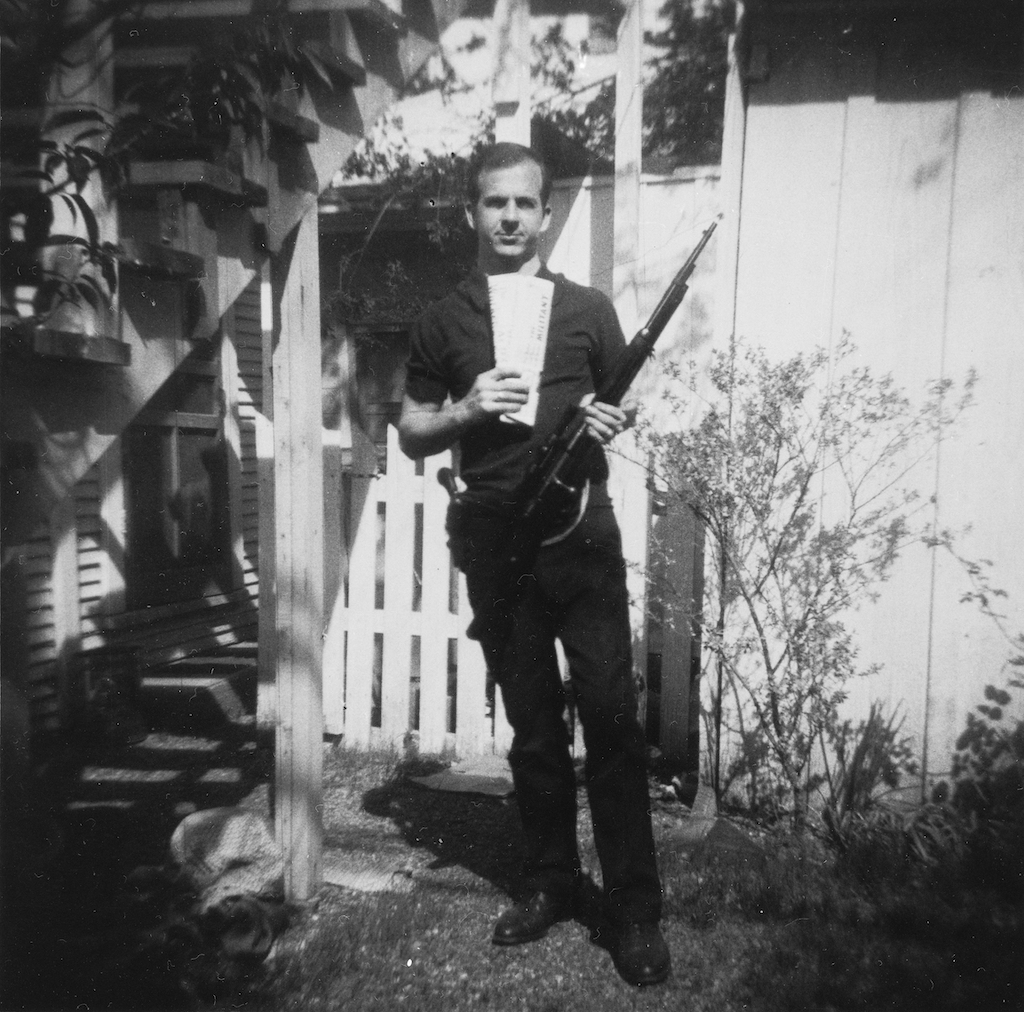
Lee Harvey Oswald Rooming House Museum
- Address: 1026 N Beckley Ave, Dallas, TX 75203
The Lee Harvey Oswald Rooming House Museum is the temporary residence that Lee lived in from October 14 to the time of the JFK assassination. Out of all of the spots on this list, this left the biggest impression to me.
Yes, it’s interesting to check out the tiny bedroom that Lee Oswald lived in and to see the rooming house still looking like a 1960s home.
But the main attraction here is talking to Miss Pat who actually grew up around the house and had personal interactions with Oswald.
She has all kinds of different stories to tell and if you believe in the “standard version” of events, she will probably blow your mind and leave you pondering a lot of questions about what happened.
You’ll need to call 469-261-7806 to book a ticket and a private tour will cost $30 per person. You’ll have up to two hours with her which will absolutely fly by.
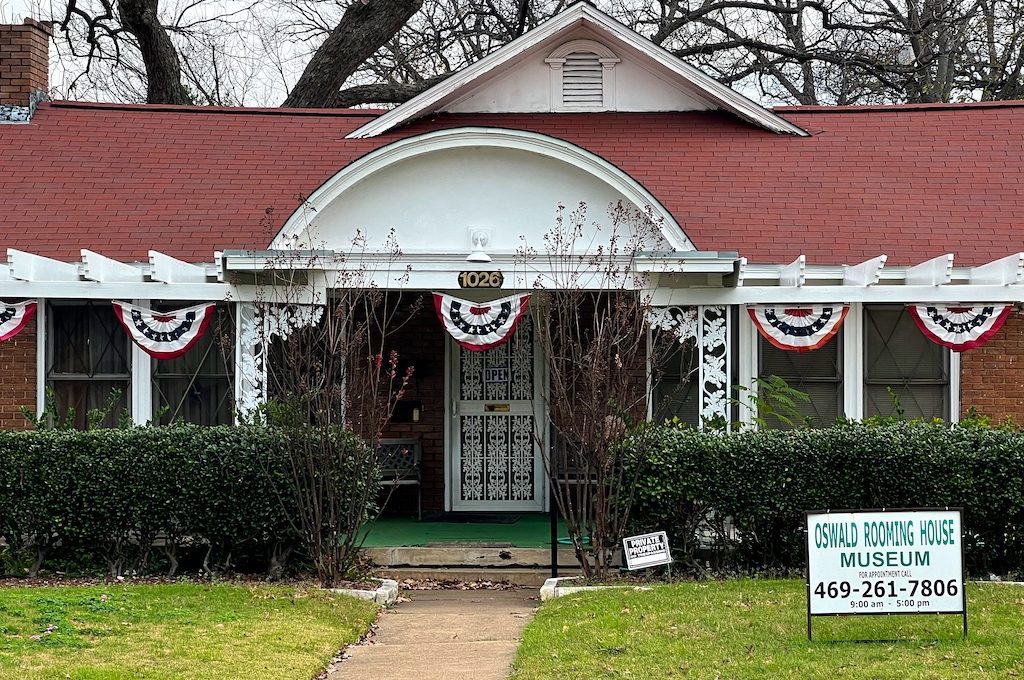
Officer Tippit memorial
- Address: E 10th St &, N Patton Ave, Dallas, TX 75203
Officer JD Tippit was an 11-year veteran with the Dallas Police Department who was patrolling the Oak Cliff area in Dallas after the assassination.
He’d been given a description of JFK’s shooter (slender white male, 5 ft 10 in, about 165 pounds) and about 45 minutes after the assassination of JFK, Tippit spotted someone who fit the description.
This suspicious person would end up being Lee Oswald.
According to eyewitnesses, as Tippit got out of his car and was having an exchange with Lee, Oswald shot Tippit several times and ultimately killed him.
Today, you can visit the intersection where the shooting occurred and view the monument marker as you pay respects for the fallen officer.
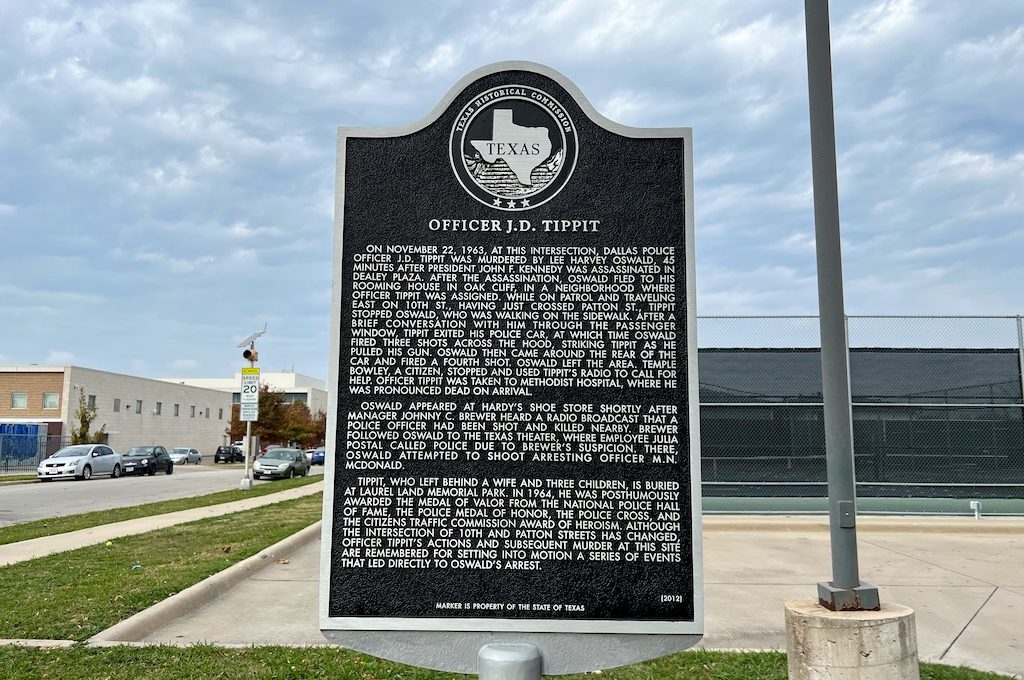
Texas Theater
- Address: 231 Jefferson Blvd, Dallas, TX 75208
After Oswald killed officer J.D. Tippit, Oswald made his way to the Texas Theater.
It’s reported that Oswald bought some popcorn and then snuck his way into a film called War Is Hell without purchasing a ticket.
After getting alerted by a neighboring store owner about a suspicious-looking Oswald, a Texas Theatre cashier phoned police.
Soon, officers arrived, the house lights were flipped on, and police found Oswald sitting with his gun near the rear of the theater.
Reportedly, Oswald tried to fire at one of the officers which resulted in an altercation. Eventually, officers wrangled him out of the building but not before Oswald took a shiner to the face.
The Texas Theater still runs shows today so you could get access into the theater by purchasing a ticket to a show.
At one point, the seat location that Oswald sat in was marked but I’m not sure if that still the case (the original seat has been removed).
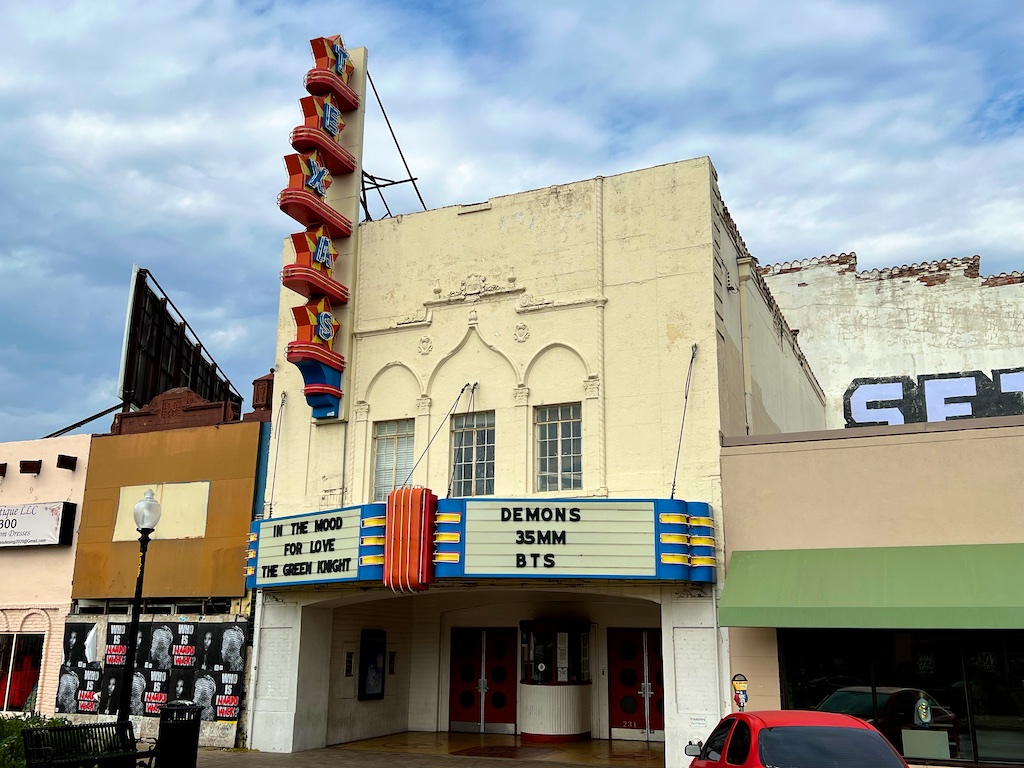
If you wanted to see things in chronological order, you could put the Dallas Municipal Building after this location. However, because that building is located in Downtown Dallas I found it easier to lump that location in with the other downtown sites.
Ruth Paine House Museum
- Address: 2515 W 5th St, Irving, TX 75060
The Ruth Paine House Museum is the former home of Ruth Paine who allowed Lee Oswald’s wife, Marina Oswald, to stay with her in 1963.
Lee Oswald would stay at this house on the weekends when he wasn’t at the rooming house.
This house is special because it’s where Lee spent his last night before the shooting and it’s also where he hid his rifle.
Now, it’s been turned into a house museum with each room representing an exhibit of sorts.
You can see the bedroom that Lee slept in and where he left his wedding ring and the cash for Marina the morning he went to work with his rifle.
If you book a tour here, you can learn a lot more about how Ruth Paine got connected with Lee Oswald and listen to stories about how she felt after she found out Oswald was the alleged assassin.
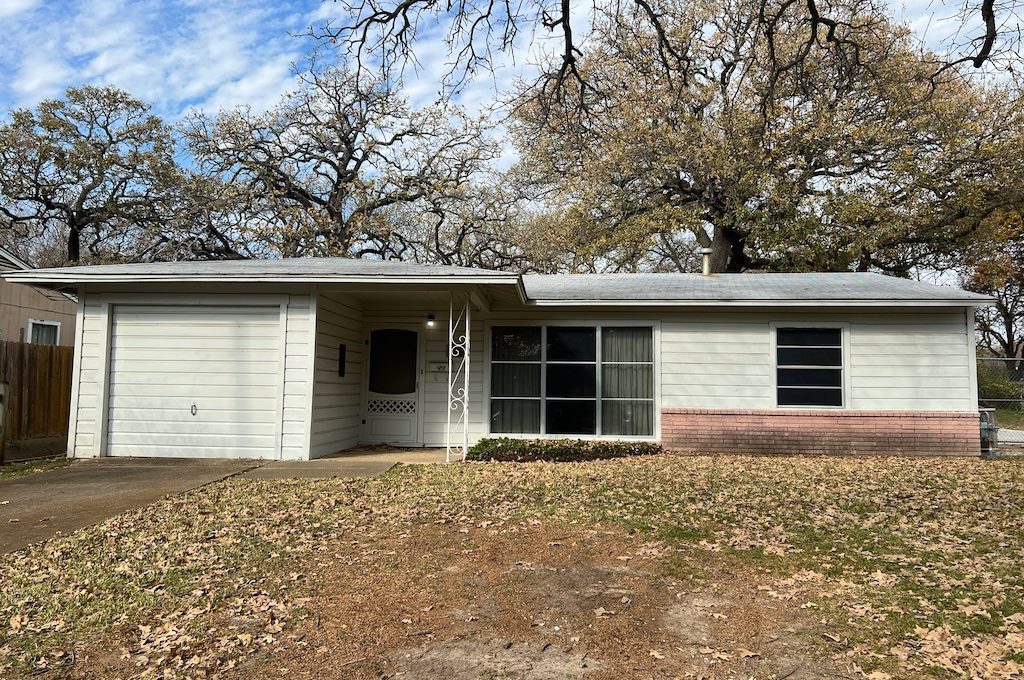
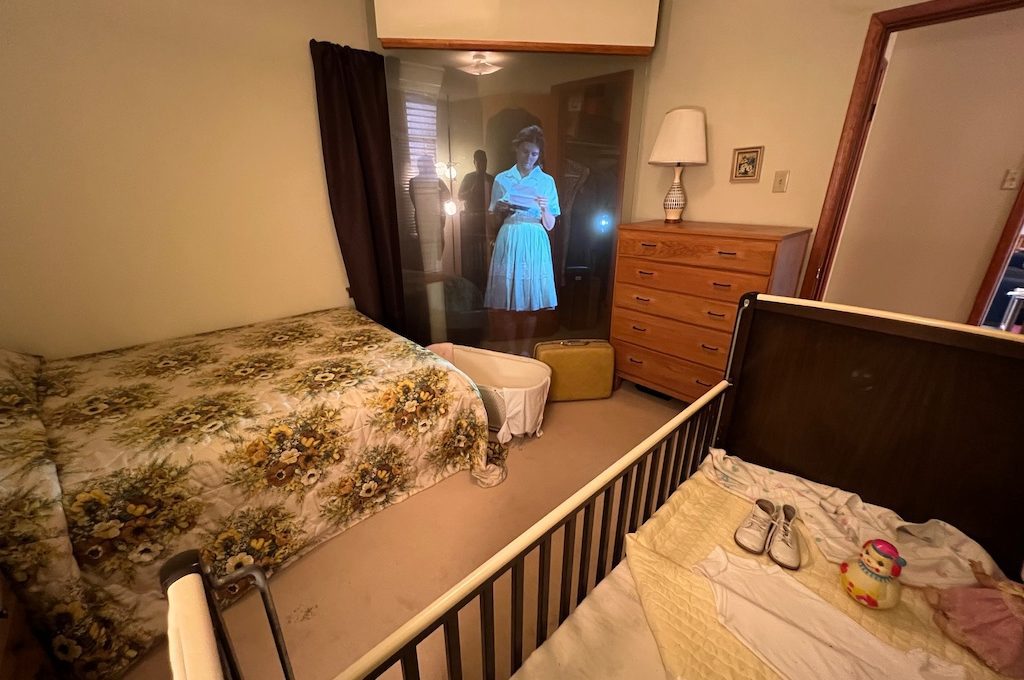
The Trade Mart
- Address: 2100 N Stemmons Fwy, Dallas, TX 75207
The Trade Mart (Grand Courtyard) is the building that JFK was headed to after the motorcade route.
It was here that lunch was going to be had and you can see the actual place setting that was prepared for him if you visit the Sixth Floor Museum.
I don’t think The Trade Mart is open to the public so you would have to contact someone in order to get access.
However, you can still drive by it and check out the JFK Trade Mart Statue & Plaque.
We chose to visit the Trade Mart and Parkland Hospital at the very end of our time in Dallas since it just made things easier but technically this would have been the end of the motorcade route.
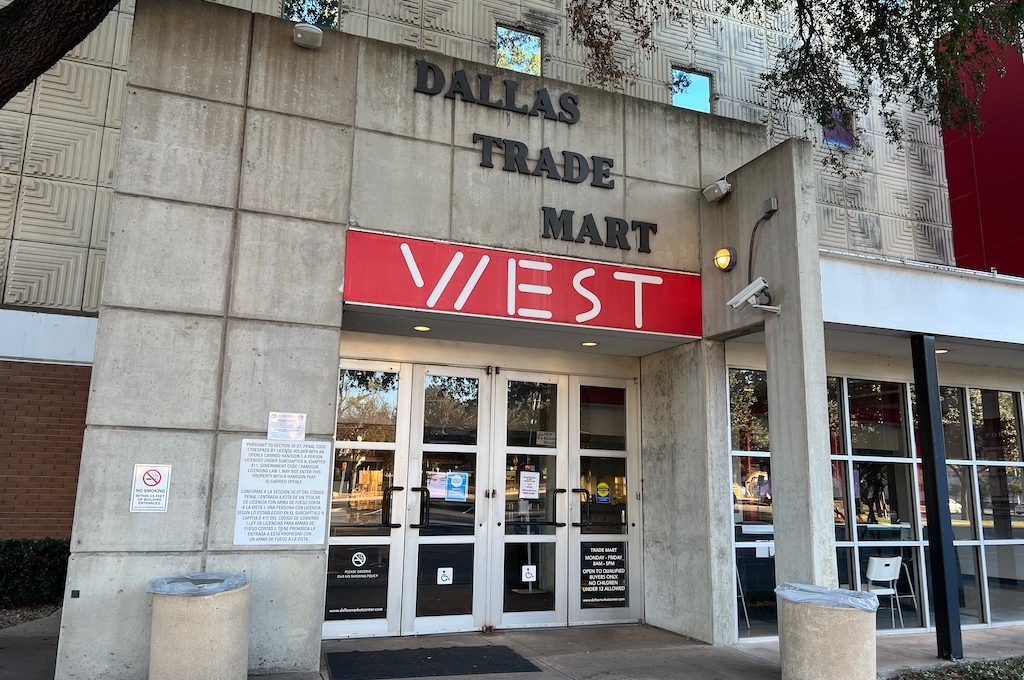
Parkland Hospital
- Address: 4666 La Rue St, Dallas, TX 75211
Parkland Hospital is where JFK ultimately came to rest.
Specifically, it was trauma room one where he would be pronounced dead at 1pm on November 22, 1963.
Parkland Hospital is also where Oswald was taken after he was shot by Ruby and Oswald would be pronounced dead at 1:07pm on November 24, almost exactly 48 hours from the time JFK passed away.
And if that wasn’t enough of events going full circle, Jack Ruby also died at this hospital after suffering a pulmonary embolism.
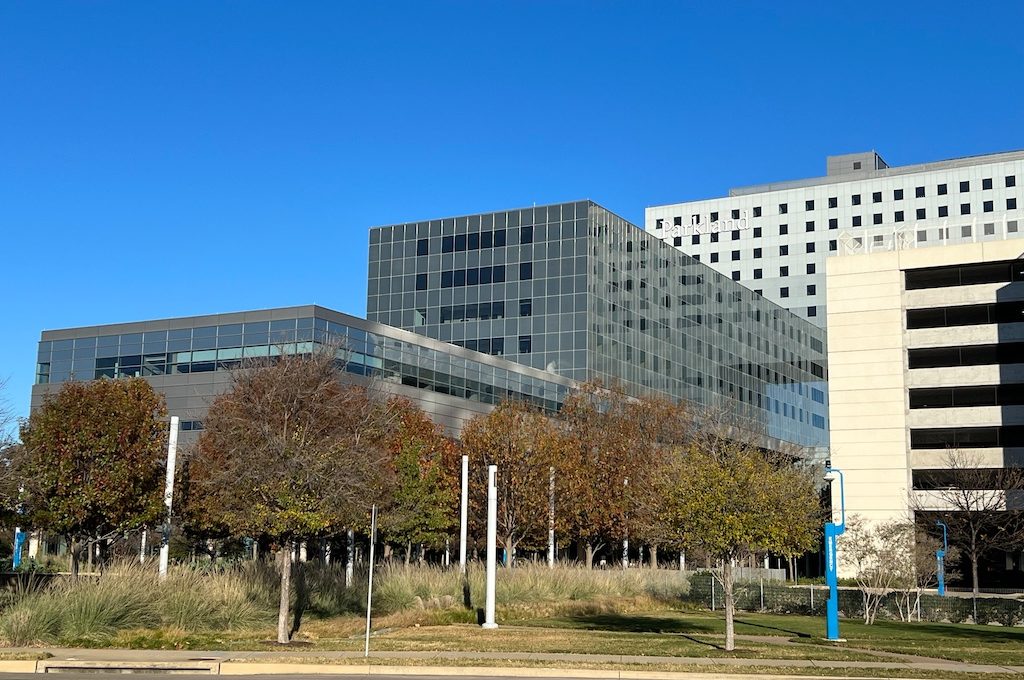
Something interesting about what happened at Parkland Hospital is that Texas law required a body to be autopsied before it could be shipped away from the state.
But because it would take so long to autopsy JFK’s body, officials worked out a compromise so that an MD would stay by JFK’s body the entire way back to DC.
Today, the exact trauma room no longer exists but there is a memorial marker in the radiology department for where it once existed.
It’s probably obvious but because this is a hospital, entry is going to be limited and so the site may not be available for much of the public.
JFK’s body was eventually buried in Arlington National Cemetery near Washington DC and his gravesite is still a major attraction today.
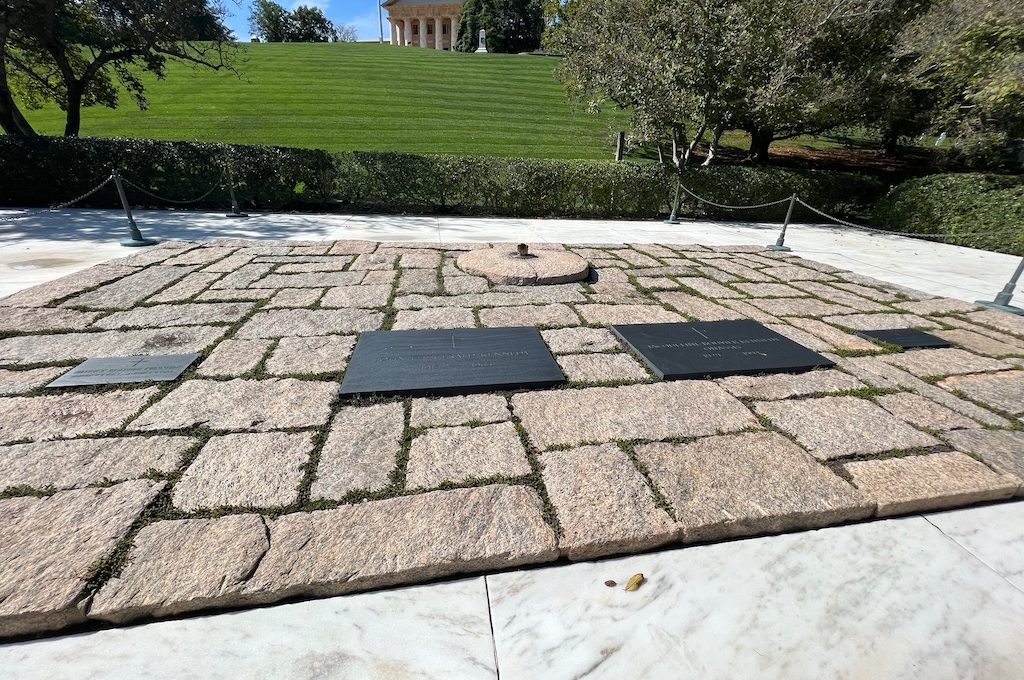
Final word
Visiting these sites will likely cause you to feel an array of emotions.
Hope, shock, skepticism, horror, all seem to arise at different times.
But there is something to be said about walking in the footsteps of history.
There’s no better way to absorb, appreciate, and understand the events that took place and while a lot of the content is pretty heavy, checking out all of these locations was worth every second to me.
Daniel Gillaspia is the Founder of UponArriving.com and the credit card app, WalletFlo. He is a former attorney turned travel expert covering destinations along with TSA, airline, and hotel policies. Since 2014, his content has been featured in publications such as National Geographic, Smithsonian Magazine, and CNBC. Read my bio.

